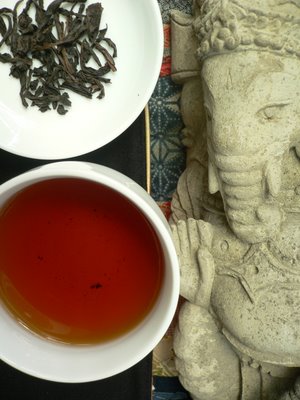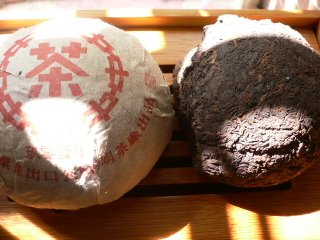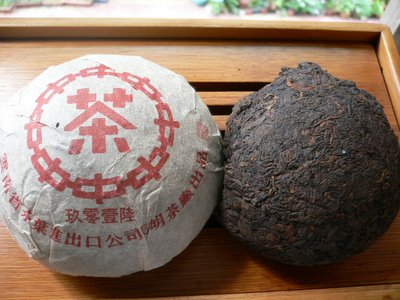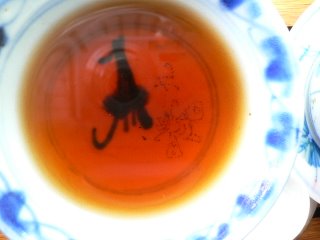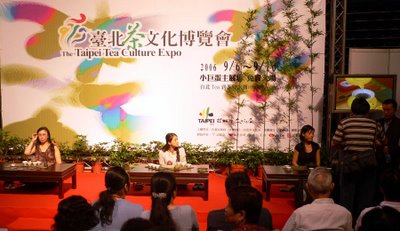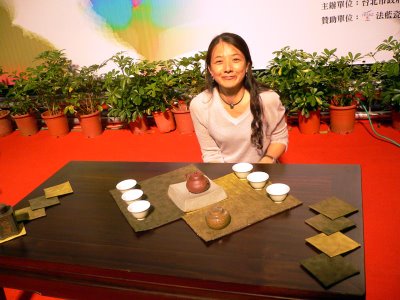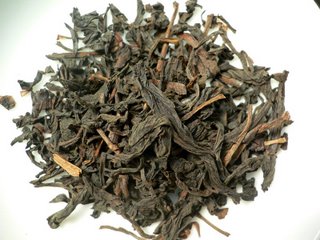
These first 2 pictures show the ideal jar for aging Oolong: a big, round shape, glazed surface and rough clay. Here, this huge jar is over 100 years old. I put a regular Yixing teapot next to it to give you a sense of its dimensions. You'll also notice that the foot of the jar is not glazed. And the thick black glaze reminds us of the color variations of Jian Yang bowls from the Sung dynasty (tenmoku). Here, the same chemical process happened during the firing of the jar. For this jar, the color became brown and black, but I've also seen one with purple tones.

The problem with this jar is that I would need to purchase approximately 8 kg of Oolong to fill it completely. If the jar is just half full, then there is too much air and the tea would oxidize too quickly (like an opened, half full bottle of wine). I think I'll eventually buy one, but not before I move into my new appartment (still under construction). Then I can find one dedicated place for it: no bad smells, no direct sunshine, dry. And I'll probably use it to store 2005 Oolong for my 1 year old daughter. Like this she'll also have nice tea to drink when she reaches 18 and later gets married. (And if she doesn't become as much a tea fanatic as me, she'll always know what leaves to bring to please her loving father!)

As an alternative to such a big jar, I have found a smaller one (above right). You'll probably recognize my modern Yixing zisha jar. I use it to let the leaves of my 1989 raw wild Jiang Cheng Puerh breathe after flaking. It's a little bit like decanting old wine, if you want. Compressed old puerh should be allowed to rest before being brewed. Such an unglazed jar will retain the fragrances while allowing sufficient air for this purpose.

I also like this Qing dynasty jar with a Chinese lion. Like with most old jars, there is no cover, so I used my Ming dynasty cup! The cup has a crack and shouldn't be used to drink tea, and the colors fit the jar. It's not very airtight, but this is not a problem, because I use it to store my 1988 cooked Gung Ding Cha Zhuan puerh. This way I get a similar result to the Yixing jar.

On the close up of the small old jar, you can see that the bottom is not glazed. A wooden top loosely fits the mouth. I'll need wax to close it more tightly. But the first problem is to get rid of the basement smell. I will put it on my balcony as soon as the coming typhoon passes its way. Fresh air and the sun should do the trick. My potter told me he got several of those in Beijing. They problably date from the 19th Century. I'll ask Teaparker next time I see him.
The question now is what kind of Oolong to put inside. Phyll wonders:
Do ageable oolongs have to be highly or heavily fired? Can the "lighter" fired one be aged long term (10-20-30 years)? I mean lighter by the fact that the tea still has some hint of greeness, but it's quite roasty too already.
With this kind of jar, in Taiwan, the best is too use a medium to heavy fired Oolong if you're shooting long term and if you don't have the equipment, skills and time to roast your tea yourself. Taiwan is quite humid and Oolong would turn bad, rot if it became too humid. So the easiest way to avoid this problem is to start with very dry leaves.
Teaparker mentionned below 6% humidity during his presentation at the Tea expo. This is how much water should still be contained in the tea leaves you purchase. (My educated guess is that most 'green' oolongs that are now so popular have higher levels, which is why they go stale quickly.)
I also asked this humidity question to my source of the 2004 Da Yu Ling Oolong (2650 m) that several of you have or will have the opportunity to taste. (This was Toki's request). And he told me that he usually gets his to 4% approximately. But he also remarked that the humidity level is not necessarily equal to the fire level. You can reach the same humidity with low, medium or high roast. What changes is the time it takes: if you want to keep the tea's 'greeness', then you need a low fire and up to 2 days of roasting.
The level of roasting can then depend on your taste and the complexity of the tea you roast (high mountain Oolong is best roasted with lighter fire). But both Teaparker and this tea roaster told me that good old Oolong has to retain greenness: after several brews the leaves will look lighter and the leaves will unfold softly. Badly roasted Oolong will remain black and its leaves are hard like plastic. So, it's not only OK to age such tea, but this is the kind of tea that has the best potential, because it's transformation will be greatest.
The 20 year old Oolong Teaparker shared last Saturday was a traditionnally fired Dong Ding Oolong and showed these attributes. Teaparker actually had stored it in a lead cannister. Lead is very heavy and keeps tea's freshness very well. Still, the tea had aged very well and was completely sweet and mellow. But, as I reported before, a 8 year old Lishan well fired Oolong aged in a big ceramic jar showed more transformation (it smelled like Cognac!)

So there are many ways to store Oolong. Best is to check and smell the tea every year or 2 to monitor it's transformation. And the other trick is to experiment with different methods, different teas, different containers. That's what I'll do with my new, old jar!
 It's one of my latest hand painted gaiwan that found its way in my selection.
It's one of my latest hand painted gaiwan that found its way in my selection.
